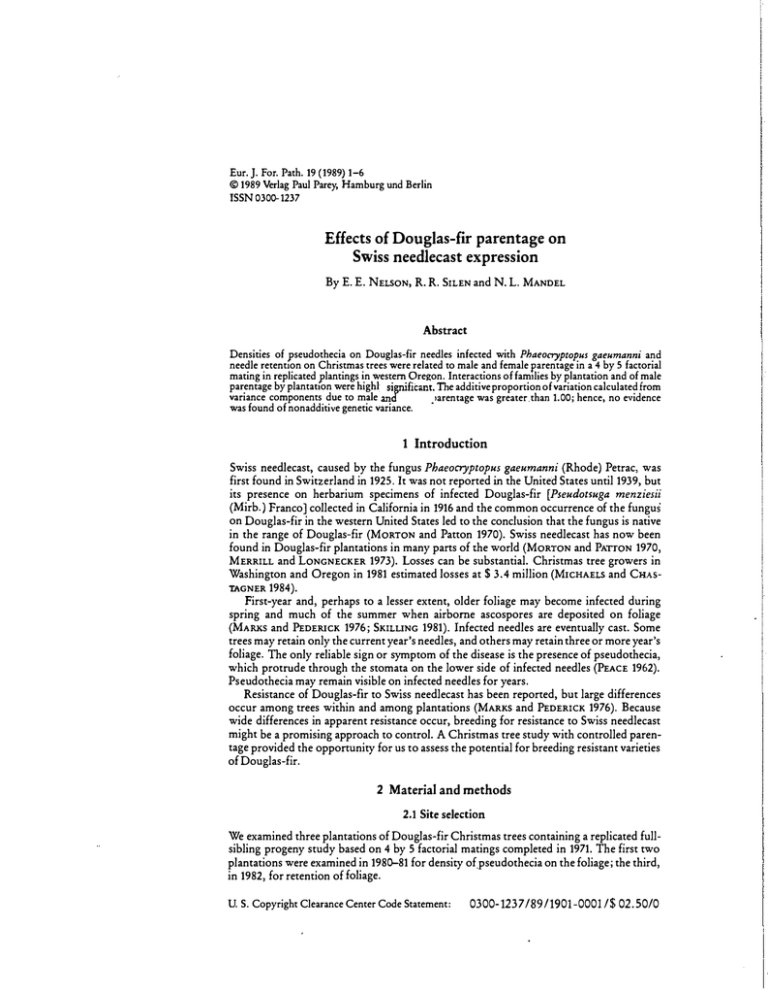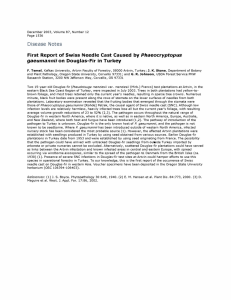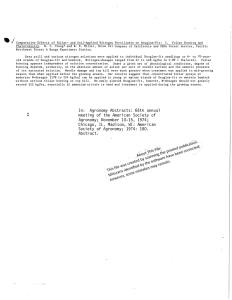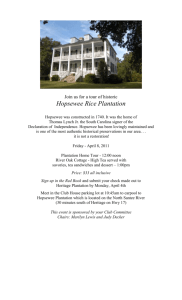Document 12787479
advertisement

Eur. J. For. Path. 19 (1989)1-6
© 1989 Verlag Paul Parey, Hamburg und Berlin
ISSN 0300-1237
Effects of Douglas-fir parentage on Swiss needlecast expression By E. E. NELSON, R.R. SrLEN and N. L. MANDEL
Abstract
Densities of pseudothecia on Douglas-fir needles infected with Phaeocryptopus gaeumanni and
needle retention on Christmas trees were related to male and female P.arentage in a 4 by 5 factorial
mating in replicated plantings in western Oregon. Interactions of families by plantation and of male
parentage by plantation were highly significant. The additive proportion of variation calculated from
variance components due to male and female parentage was greater.than 1.00; hence, no evidence
was found of nonadditive genetic variance.
1 Introduction
Swiss needlecast, caused by the fungus Phaeocryptopus gaeumanni (Rhode) Petrac, was
first found in Switzerland in 1925. It was not reported in the United States until 1939, but
its presence on herbarium specimens of infected Douglas-fir [Pseudotsuga menziesii
(Mirb.) Franco] collected in California in 1916 and the common occurrence of the funguS
on Douglas-fir in the western United States led to the conclusion that the fungus is native
in the range of Douglas-fir (MORTON and Patton 1970). Swiss needlecast has now been
found in Douglas-fir plantations in many parts of the world (MORTON and PATION 1970,
MERRILL and LONGNECKER 1973 ). Losses can be substantial. Christmas tree growers in
Washington and Oregon in 1981 estimated losses at $ 3.4 million (MICHAELS and CHAs­
TAGNER 1984).
First-year and, perhaps to a lesser extent, older foliage may become infected during
spring and much of the summer when airborne ascospores are deposited on foliage
(MARKS and PEDERICK 1976; SKILLING 1981). Infected needles are eventually cast. Some
trees may retain only the current year's needles, and others may retain three or more year's
foliage. The only reliable sign or symptom of the disease is the presence of pseudothecia,
which protrude through the stomata on the lower side of infected needles (PEACE 1962).
Pseudothecia may remain visible on infected needles for years.
Resistance of Douglas-fir to Swiss needlecast has been reported, but large differences
occur among trees within and among plantations (MARKS and FEDERICK 1976). Because
wide differences in apparent resistance occur, breeding for resistance to Swiss needlecast
might be a promising approach to control. A Christmas tree study with controlled paren­
tage provided the opportunity for us to assess the potential for breeding resistant varieties
of Douglas-fir.
2 Material and methods
2.1 Site selection
We examined three plantations of Douglas-fir Christmas trees containing a replicated full­
sibling progeny study based on 4 by 5 factorial matings completed in 1971. The first two
plantations were examined in 198 81 for density of_pseudothecia on the foliage; the third,
in 1982, for retention of foliage.
U. S. Copyright Clearance Center Code Statement:
0300-1237 /89/1901-0001/$ 02.50/0
E. E. Nelson, R. R. Si/en and N. L. Mandel
2
Plantations 1 and2 were near Portland, Oregon (North Plains), and Lebanon, Oregon,
respectively. Each plantation had two replications; each mating was represented by a row
of five progeny per replication (some matings were represented by four progeny per row
because of mortality or early removal).
2.2 Sampling
Branch samples were collected at the North Plains plantation from three points equidis­
tant on the circumference of the tree beginning on the south side at 0.6--0.9 m from the
ground. Uninfected needles were extremely rare on any of the examined branches. Three
second-yr needles were selected from each branch, the nine needles were cemented top
side down to a card and all fruiting bodies on the undersides of needles were tallied by
using a dissecting microscope. The number of pseudothecia per mm was calculated from
total number of fruiting bodies divided by total length of the nine needles. This number
was then averaged for each family. Sampling of the Lebanon plantation was less intensive.
One branch 0.6-0. 9 m above ground on the south side of each tree was clipped and one
second-yr needle was selected at random for observation. Single needles from each of four
trees representing one family were pressed onto a strip of cellophane tape, the needles re­
moved, and the tape mounted on a microscope slide. Fruiting bodies adhering to the tape
were tallied across a 1-mm strip transversing the four needles. Total count on the 1-mm
strip across the four needles was divided by four and used as an average for the family.
We sampled the third plantation near Corvallis, Oregon, in October 1982 for family
differences in years of needle retention. One branch was selected from 1.2 m height on the
south side of each of 10 progeny (5 in each of2 replicate plantings) of each family. For each
branch, the number of years of> 50 o/o needle retention was recorded and averaged for the
10 trees.
2.3 Data analysis
Analysis of variance (ANOVA) was done by using the SPSS statistical package. Separate
ANOVAs for the rwo plantations were run as well as an ANOVA for the two combined.
Differences were judged significant at p < 0.05.
For the relation between family mean number of pseudothecia per millimeter of needle
length at plantations 1 and 2 versus average years of needle retention by family at planta­
tion 3, a simple correlation was calculated. The additive component of variation (VA) was
estimated by averaging the additive components of variation due to male and female par­
ents. T he additive component of variation for female parents (VFA) was computed by the
formula:
4 (MSF - MSFXM)
V FA =
rxm
mean square for males x female interac­
where MSp mean square for females, MS Fx M
total number of replications, and m
number of male parents. Calculations for
tion, r
additive components of variation for males (V MA) were similar. The additive portion of
variation due to male and female effects is:
=
=
=
=
VFA +VMA
3 Results
Table 1, in which the parentage is ordered by increasing pseudothecia counts, shows a
clear additive trend in density of pseudothecia. Male and female parents with the lowest
average counts produced families with low counts: Mal_e and female parents with high
Effects of Douglas-fir parentage on Swiss needlecast expression
3
Table 1. Average numbera of Swiss needlecast pseudothecia per millimeter of needle length for Douglas-fir matings of 4 male and 5 female pare nts Female parent
55
36
43
45
53
I
40
18.3
18.3
22.8
14.0
20.3
18.7
Average
Male parent
58
I
12
I
18.8
18.5
23.8
27.0
23.3
22.3
38
I
29.8
29.5
24.5
31.3
33.0
29.6
I
Average
14.8
27.8
28.5
31.5
44.3
29.4
20.4
23.5
24.9
25.9
30.2
Based on average of families between 2 plantations : plantation 1, North Plains, and plantation 2,
Lebanon
a
counts produced families with high counts. Two male parents had families with high
numbers of pseudothecia, and two had low numbers. Among female parents, the families
were distributed more normally (Table 1). ANOVA over both sites indicated significant
differences in average numbers of pseudothecia per mm among tested male parents (Table
2). There were highly significant interactions of families and males by plantations. On one
of the two sites (plantation 2 near Lebanon), the differences among female parents also
were significant.
Separate analysis of each plantation provided a reasonably clear rationale of why the
ANOVA showed only a general male contribution plus a family-by-plantation interacTable 2. ANOVA of average number of pseudothecia per millimeter of needle length from 2
Dougl as-fir Christmas tree plantations infected with Swiss needlecast
Source
I
SS
I
df
I
MS
F
I
I
Sig
Combined plantations
Plantation(P)
Reps within plantation(error 1)
Family(FAM)
Female(F)
Male(M)
MXF
FAM x P (error2)
FXP
MXP
MXFXP
Residual(error 3)
Total
28.8000
298.2500
6612.0750
823.0750
1746.6500
1484.2250
3381.2000
802.3250
149.5000
2429.3750
2891.7500
13212.0750
1
2
(19)
4
3
12
(19)
4
3
12
38
79
Rep
Female
Male
Male by female
Residual
Total
297.0250
1201.5000
875.4750
3173. 9000
1483.4750
7031.3750
1
4
3
12
19
39
Rep
Female
Male
Male by female
Residual
Total
1.2250
423.9000
1020.6750
739.7000
1408.2750
3593.7750
28.800
149.125
348.004
205.769
582.217
123.685
177.958
200.581
49.833
202.448
76.099
0.19
0.703
1.96
1.16
3.27
0.70
2.34
2.64
0.65
2.66
0.076
0.361
0.043
0.737
0.013
0.049
0.585
0.011
Plantation 2(Lebanon)
297.020
300.375
291.825
264.492
78.078
3.80
3.85
3.74
3.39
0.066
0.019
0.029
0.009
Plantation 1 (North Plains)
1
4
3
12
19
39
1.225
105.975
340.225
61.642
74.120
0.02
1.43
4.59
0.83
0.899
0.263
0.014
0.620
4
E. E. Nelson, R. R. Silen and N. L. Mandel
Table 3. Mean yearsa of Douglas-fir needle retention for matings of 4 male and S female
parents at plantation 3, Corvallis
Female parent
55
36
43
45
53
I
40
4.1
4.1
3.6
3.8
3.6
3.84
Average
I
58
Male parent
I
4.0
4.0
3.6
3.3
3.2
3.62
12
3.6
3.2
3.4
3.5
3.5
3.44
I
38
4.2
4.0
3.6
3.9
3.6
3.86
I
Average
3.98
3.82
3.55
3.63
3.47
Average of 10 trees (5 trees per family in each of 2 replicated areas) based on number of years
of> 50 o/o needle retention on south-facingbranch 1.2 m high.
a
tion. For the first plantation, only the response of males was significant (P
0.014).
Female and male-by-female interactions were not significant. For the second plantation,
all three sources of variation in the analysis were significant (males P
0.029, females P
0.019, and male-by-female P 0.009). Male response was thus consistent on both planta­
tions and when combined across two plantations. Female responses for combined planta­
tions were negated by lack of response on plantation 1, and the different responses by
plantation was the source of the significant family-by-plantation interaction.
The negative correlation between mean numbers of pseudothecia per mm of needle
length and years of needle retention (Table 3) of the 20 families was significant (r
-0.47,
d. f.
18, p 0.04) despite the site differences and measured variables. The additive pro­
portion of variation computed from the variance components and due to male and female
effects was greater than 1.00: hence, we saw no evidence of nonadditive variation.
=
=
=
=
=
=
=
4 Discussion
The study adds some understanding of the genetic response of Douglas-fir to Swiss
needlecast infection but left unanswered the question of inherent resistance. The number
of pseudothecia per mm of needle length, although a convenient trait to record and one
displaying inherent differences among families, may not be a good measure of relative
resistance. In this investigation, every plantation tree sampled on the three sites had in­
fected needles. We also checked other plantation and native trees near Corvallis and found
varying proportions of infected needles on every tree we checked in 1981. Likewise, all
trees in a provenance trial in Australia were infected. No evidence of immunity has been
found under the climatic conditions of that region, but there was evidence of relative dif­
ferences in apparent damage among the provenances. Provenances from southern latitudes
(California and southern Oregon) and from higher elevations were more susceptible to
Swiss needlecast in Australia (MARKS and FEDERICK 1976). Low-elevation California
coastal provenances appeare"d highly susceptible. Those from low elevations along the
central Oregon coast appeared least susceptible. Similar observations were made in New
Zealand (Hoon 1983). Most plantations in the Lake States contain a high percentage of
trees having no infected branches (SKILLING 1981). Differences in climate from place to
place undoubtedly affect susceptibility and may mask genetic resistance if otherwise resis­
tant trees are subjected to abundant inoculum and conditions conducive to infection
(PEACE 1962). Infection may be aggravated by abnormally wet weather (MARKS and
K.ASSABY 1975). Cultured Christmas trees may be subject to heavier infection than are adja­
cent forest trees because the Christmas trees are generally not from appropriate climatic
zones and because the dense, bushy trees resulting from shearing may provide a micro­
climate more favorable for disease devel_opment.
Effeas of Douglas-fir parentage on Swiss needlecast expression
5
The retention of infected needles, which is common in some trees, has been suggested
as a type of genetic resistance; however, infected trees that appeared healthy grew no faster
in diameter than did th<>Se chat were obviously diseased (McKrMM 1975). We did not have
the resources, and these trees, which were scheduled for cutting, were not appropriate
study material for assessing relative growth loss from differing pseudothecia densities.
Loss of needles in commercial Christmas tree plantations in Washington and Oregon in
1981, the year of our counts of pseudothecia, contributed to a reduction in grade for large
numbers of trees (MICHAELS and CHASTAGNER 1984). The relation we obtained between
needle retention and density of pseudothecia was rather weak though significant. Part of
this weakness may have been due to the comparison of the same families on different plan­
tations rather than the same trees in one plantation. Other authors found that discolora­
tion of foliage and shedding of needles did not necessarily correlate with heavy infection,
based on density of pseudothecia (PEACE 1962).
Our counts were interesting because they showed the complex expression of genetic
response to a foliage disease. The clear genetic differences in mean numbers of
pseudothecia per mm of needle lengrh from different pollens on the same female parent
left no doubt that the differences are inherent. We found no evidence of nonadditive
genetic variance. A similar finding is reported for susceptibility of Pinus radiata D. Don
to western gall rust [Endocronartium harknessii Q. P. Moore) Y. Hirat] (Ow et al. 1986).
Yet, we found that the influence of female parents on their family was so different between
the two sites as to show no average effect over combined sites. A highly significant interac­
tive response suggested that the number of pseudothecia is expressed quite differently
from one family to the next, site by site.
Acknowledgements
We gratefully acknowledge the assistance of BoB COWDEN (d eceased), and MIKE McWILLIAMS, in
collecting foliage sam ples and for the m any tedious hours spent counting pseudothecia and tabulat­
ing results.
Summary
Three Douglas-fir Christm as tree plantations in western Oregon were exam ined for Swiss need lecast
in 1980-82: two for d ensity of pseudothecia, and one for retentionof infected foliage. The replicated
4 X 5 factorial m ating d esign of each plantatio n presented the opportunity to relate density of
pseudothecia and foliag e retention tomale and fem ale parentage.
Density of pseudothecia was expressed as numbers of pseudothecia counted under a d issecting
m icroscope per mm of needle length. Density of pseudothecia d iffered significantly among m ale
parents on both p lantations and among fem ale parents on one of two plantations. The variation
com puted from the variance com ponents and d ue tom ale and fem ale effects was ad d itive.
Foliage retention was expressed as number of years that more than 50 °/o of full foliage com ple­
ment was retained on a branch. Negative correlationof d ensity of pseudothecia and foliag e retention
among the 20 fam ilies was significant. The d emonstrated d ifferencesin d ensities of pseudothecia as a
result of d ifferent pollens on a fem ale parent are clearly inherent. The correlation of densities of
pseudothecia with foliage retention support the contention that breeding more m arketable Christ­
m as trees in the presence of Swiss needl ecast can be practical.
Resume
Effets parentaux sur !'expression de la rouille suisse chez le Douglas
Trois plantations d e Douglas pour arbres d e Noel, clans l'Ouest d e !'Oregonont fait l'objet d 'obser­
vations d e la rouille suisse en 1980-82: deux pour la d ensite d e s pseudorhecies et une pour la persi­
stance d u feuillage infecte. Le plan de croisem ent factoriel 4 x 5 Oe chaque plan tation donnait l'op­
ponunite d e relier la d ensire des pseudothecies et la persistance d u feuillage a la parente m :ile et
fem elle. . La d ensite d es pseudothecies a ete exprim ee en nombre d e pseudothecies com pt es sous binocu­
la1re, par mm d e longueur d 'aiguilles. Cette d ensite variait significativem ent parm i !es parentsm :iles
E. E. Nelson, R.R. Silen and N. L. Mandel
6
dans les deux plantations et panni les parents femelles clans l'une des deux. Les differences evaluees a
parcir de la variance et due aux effets paternels et maternels eraient additives.
La persistance foliaire f:tait exprimfe en nombre d'annfes pour lesquelles plus de 50 o/o du feuil­
lage ftait present. La correlation nCgacive entre la densite des pseudothfcies et la persistance foliaire
ftait significative pour les 20 feuilles. II est clair que les differences de densitC des pseudothfcies sont
le rCsultat de la fCcondation des parents femelles par diffCrents pollens. La correlation entre les de­
nsites de pseudothCcies et la perte foliaire renforce l'idCe qu'il est possible de sClectionner des arbres
deNoel commercialisabels en presence de rouille suisse.
Zusammenfassung
Einflufl der Elternbtiume aufdie A.Jtsprtigung der Rufligen DouglasienschUtte
in Weihnachtsbaumplantagen
Drei Douglasien-Weihnachtsbaumplantagen im westlichen Oregon wurden 1980-1982 auf dasAuf­
treten der RuBigen Douglasienschiltte hin untersucht. In zwei der Plantagen wux=de die Dichte der
FruchtkOrper, in einer die Dauer des Verbleibens der Nadeln am Baum registriert. Die Art der
Anlage der Fliichen (4 X 5 faktorielles Kreuzungsmuster, wiederhoh) ermO lichte es, FruchtkOrper­
dichte und Verweildauer derNadeln zum jeweiligen miinnlichen oder weibhchen Elter in Beziehung
zu setzen.
Die FruchtkOrperdichte {= Pseudothezienzahl/mm Nadelliinge) wurde unter dem Pr3pariermi­
kroskop bestimmt. Sie schwankte in beiden Plantagen signifikant inAbhingi keit vom minnlichen
Elter und auf einer Plantage inAbhangigkeit vom weiblichen Elter. Die Variation, berechnet aus den
Varianzfaktoren und bedingt durch die Einflilsse der miinnlichen und weiblichen Elternbaume, war
additiv.
Die Verweildauer derNadeln wurde als Zahl der Jahre ausgedriickt, w3hrend derer die Triebe zu
mehr als 500/o benadelt waren. Eine negative Korrelation zwischen FruchtkOrperdichte und Nadel­
verweildauer war zwischen den 20 Familien signifikant. Die aufgezeigten Unterschiede in der
FruchtkOrperdichte sind deutlich das Ergebnis verschiedenen Pollens bei dem jeweiligen weiblichen
Elter. Die Korrelation zwischen FruchtkOrperdichte und Nadelverweildauer deutet darauf hin, daB
die Zilchtung gegen die RuBige Douglasienschiltte widerstandsfahiger und damit besser verkauf­
licher Weihnachtsb3.ume mOglich ist.
References
HooD, I. A., 1983: Swiss needle-cast of Douglas-fir. Forest Pathology inNew Zealand. Forest Re­
search Institute. Rotorua (No. 2). 4 pp.
MARKS, G. C.; KASSA.BY, F. Y., 1975: Identification of Phaeocryptopus gaeumanni on Douglas-fir.
A summary of research for 1974. Forests Commission of Victoria, Melbourne (Australia). p. 24.
MARKS, G. C.; FEDERICK, L. A., 1976: Sensitivity of Douglas-fir provenances to Swiss needle cast
disease. A summary of research for 1975. Forests Commission of Victoria, Melbourne (Au­
stralia). pp. 12-13.
McKIMM, R. J., 1975: The distribution and effect on tree growth of Phaeocryptopus gaeumanni.
A summary of research for 1974. Forests Commission of V ictoria, Melbourne (Australia). pp.
24-25.
MERRILL, W.; LONGNECKER, J., 1973: Swiss needlecast of Douglas-fir in Pennsylvania. Plant Dis.
Rep. 57, 984.
MICHAELS, E.; CHASTAGNER, G. A., 1984: Distribution, severity; and impact of Swiss needlecast in
Douglas-fir Christmas trees in western Washington and Oregon. Plant Dis. 68, 939-942.
MORTON, H. L.; PATTON, R. F., 1970: Swiss needlecast of Douglas-fir in the Lake States. Plant. Dis.
Rep. 54, 612-616.
OLD, K. M.; LIBBY, W. J.; RusSELL , J. H.; ELDREDGE, K. J., 1986: Genetic variability in susceptibil­
ity of Pinus radiata to western gull rust. Silvae Genet. 35, 145-149.
PEACE, T. R. , 1962: Pathology of trees and shrubs. Oxford University Press. 723 pp.
SKILLING, D. D., 1981: Control of Swiss needlecast in Douglas-fir Christmas trees. Amer. Christ­
mas Tree J. 25, 34-35, 37.
Author's address: E. E. NELSON, Plant Pathologist; R. R. SILEN, Plant Geneticist, and
N. L. MANDEL, Mathematicial Statistician, U.S. Department of Agriculture,
Forest Service, PacificNorthwest Research Station, Forestry Sciences Laboratory;
3200 Jefferson Way, Corvallis, Oregon 97331, U.S.A.
Receipt ofms..- 20.6.1988





